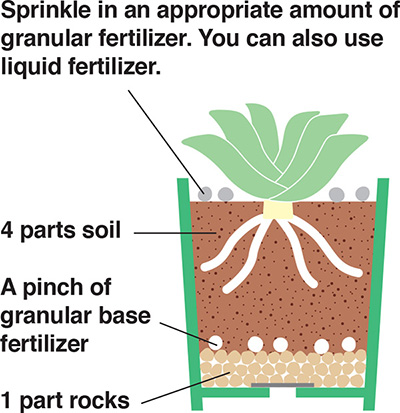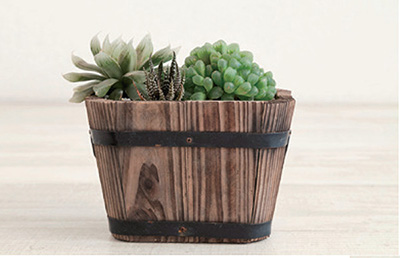Spring/Fall Types
Haworthia pilifera / H. obtusa

Characteristics of H. pilifera and H. obtusa
These varieties grow in the arid regions of South Africa under the shade of trees and grasses. As a result, they don’t like to be grown in direct sunlight. The top sides of the leaves on these unique succulents are see-through like glass, and referred to as “leaf windows.” In their natural habitat, these plants grow partway underground while the windows sit above ground for photosynthesis.

Points to Check when Buying
Avoid etiolated plants whose green color is too pale and that are too tall and stretched out. Look to see if the leaves are properly glossy and plump.

Soil Composition
Mix 5 parts small-grain Akadama, 3 parts Kanuma soil, and 2 parts mulch for a ratio that has good drainage, water retention, and breathability. Add a layer of gravel like large-grain Akadama or pumice to the bottom of the pot.

Fertilizer
When you transplant a succulent, add a layer of granular base fertilizer on top of the layer of gravel.
How to Transplant
Pull out the seedling and remove any darkened, withered roots. Pour in new soil, spread the roots apart, and plant the succulent. Start watering after the plant has spent 4–5 days in partial shade.

Pour in the slightly dampened new soil. When you have finished transplanting, lightly tap the pot to level the soil and place the plant in partial shade to take root.
How to Propagate
You can propagate these succulents through leaf cuttings, stem cuttings, or division. To use a leaf cutting, move the stem left and right and carefully remove a leaf. Then, let the cut end of the leaf dry before inserting it into soil.
Leaf Cutting

Let the leaf you removed from the mother plant dry for about a week, then insert it into damp soil. It will soon take root and sprout, so raise it that way until it grows large.
Division

When an offset grows on the side of the mother plant, cut it off.

Plant the offset in fresh soil.
Key Points for Growing H. pilifera and H. obtusa
In the wild, these plants grow at the bases of bushes and trees, so grow them in partial shade and out of direct sunlight. You can use 50% shade netting to soften the sunlight, but if you shade a plant too much it will become etiolated. When the sunlight is at its strongest during midsummer, you will need shade netting of 80% or higher. These varieties hate the heat and high humidity of summer, so make sure your plant has good ventilation and water it less frequently. During the growth periods, give your plant lots of water after the soil has dried.
Cultivation Calendar

Succulent Advice Q&A
Q I placed my plant in the sun and it turned red. I don’t know what to do!
A Haworthia plants live in partially shady environments, so if your succulent is exposed to strong, direct sunlight, it will turn red. Consider it impossible to grow your succulent out in the sun. If you put up something like shade netting (cheesecloth) and grow your plant in partial shade, it should gradually lose its redness and return to normal.


These varieties prefer sunlight filtering through trees over blinding, direct sun. These are curious plants that take in that sunlight through the “windows” on their leaves.
Members of the Haworthia Genus

H. tortuosa variegata

H. cooperi variegata

H. comptoniana

H. odetteae

H. truncata ※ Sensitive to the heat and high humidity of summer

H. truncata maughanii ※ Sensitive to the heat and high humidity of summer